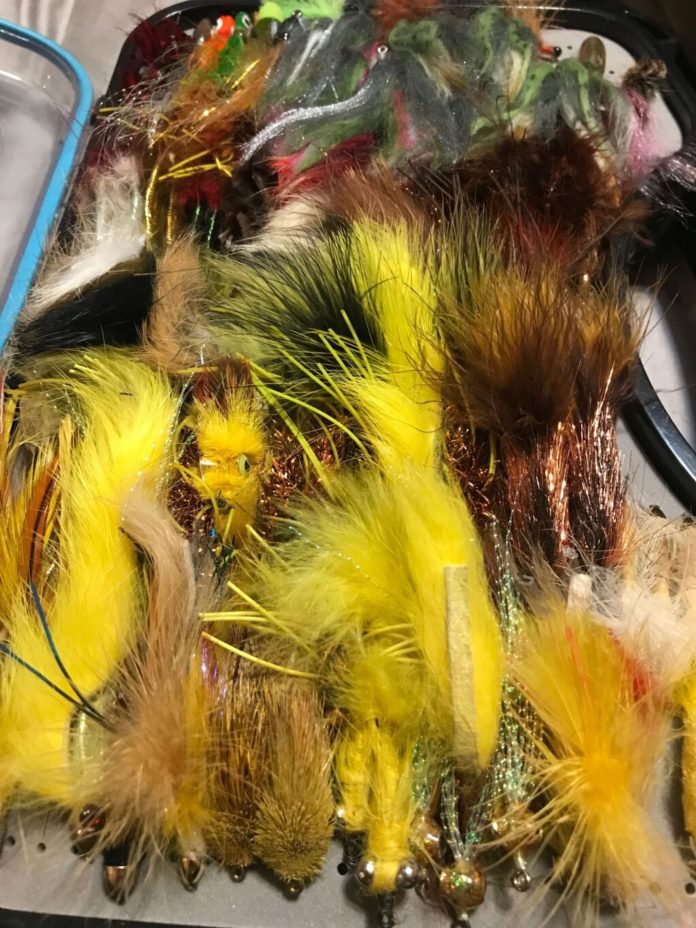Courtesy photo
The evening air in the mountains has already begun to show signs of fall. There is a slight tinge in the leaves. Berries ripe from months on the branch now weigh heavy on the boughs. And the trout in the rivers are beginning to show their hierarchy at the top of the aquatic food chain by chasing, smashing and devouring streamer flies.
Streamer flies are in a class of their own, representing a broader variety of aquatic species that includes leeches, minnows, crayfish and more. When the cool night air ushers a change in attitude, knowledgeable anglers reach for sinking-head lines, large arbor reels and 6wt minimum. Whether pounding the banks from rafts or fished through a structure when wading, streamer flies move big fish in the autumn.
Anglers will benefit from a firm grip on casting fundamentals. Streamer flies tend to be heavier and require more advanced casting skills to fish them efficiently. A good double haul is a necessity for streamer fly-fishing. Anglers who conquer the skills necessary for good streamer fishing will experience an immediate improvement with their crossover pursuits in saltwater to chasing northern pike.
Courtesy photo
Streamer fly-fishing skills translate easily to freshwater fly-fishing for large-mouth bass. In many areas of south Florida, streamer fishing produces a variety of exotic species too, such as peacock bass, Mayan cichlids and snakeheads.
Anglers able to incorporate streamer fly-fishing into their skill set are more versatile anglers. Having the confidence to cover more situations with a fly will make you a better fly-fisher. Streamer fly-fishing opens doors to challenging species previously unreachable on the fly and now become regular targets. Without good streamer skills, fly anglers have little hope of ever catching a Northern Pike on the fly, a fish regularly pursued by local fly anglers.s
Streamers will produce larger average size trout in the fall. Fish become more aggressive and are looking for a larger bite of protein. Streamers fill the gap nicely. Aggressive feeders are willing to chase streamer flies a considerable distance before committing. Anglers keyed into the reaction bite streamers illicit are guaranteed to have a banner day on the water.
Courtesy photo
Streamer flies do come in a variety of weights from light, unweighted flies to bead-head or cone-head streamers to articulated, weighted-body streamers. The price of streamer flies can be considerably higher than dry flies or nymphs; however, the amount of time involved in tying a streamer is significant and the amount of materials increases as well. Are they worth the extra cost? You bet.
Another benefit of the articulated streamer fly is its versatility. Articulated streamers can be dead-drifted in the current to imitate an injured baitfish. They can also be stripped with a swimming action that brings up some of the largest trout in the river.
An old school technique for fishing streamers that originates from Gary LaFontaine is to cast from the boat to the bank. Apply a downstream mend, pulling the fly with the current. The belief is that injured or disoriented baitfish don’t have the strength to swim upstream, are carried downstream with the current and become vulnerable.
There are a tremendous amount of streamer lines designed to make casting large, heavy flies more enjoyable. The lines assist anglers in turning over their loop, preventing big hooks from embedding in backs, hats or your guide. Airflo fly lines offer a streamer max short, long and shovel-head that can assist in casting and presenting your flies.
Short leaders are commonplace. Terminal rigs in the 5-inch range sink the flies and control the presentation. A no-slip loop knot or Lefty Kreh’s knot aids in giving the fly a sense of life. The loop knot allows the fly to swing more freely in the current.
Streamer flies entice large-bodied fish into eating. Swimming through the river drawing reaction strikes from aggressive brown trout and territorial rainbows. Streamers cover more water actively — and as the fall nights start to take hold of river temperatures, the streamer bite is only going to get better.
Michael Salomone moved to the Eagle River valley in 1992. He began guiding fly-fishing professionally in 2002. His freelance writing has been published in magazines and websites including: Southwest Fly Fishing, Fly Rod & Reel, Eastern Fly Fishing, On the Fly, FlyLords, the Pointing Dog Journal, Upland Almanac, the Echo website, Vail Valley Anglers and more. He lives on the bank of the Eagle River with his wife, Lori; two daughters, Emily and Ella; and a brace of yellow Labrador retrievers.
Credit: Source link































